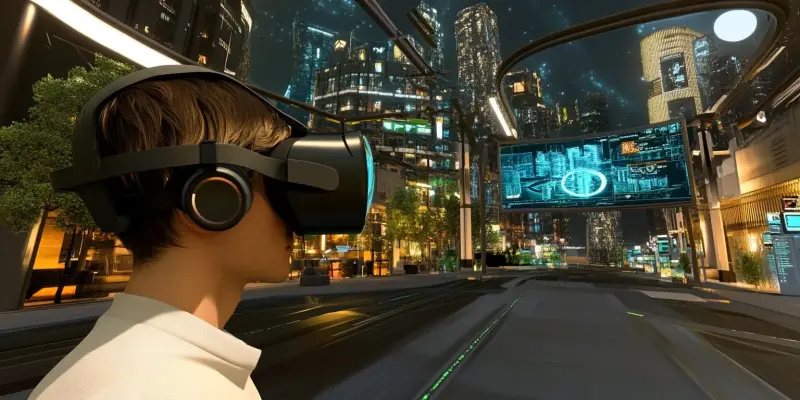Metropolis is an innovative virtual platform crafted by siblings Rania and Rashid Ajami that is designed to bridge the gap between Web2 and Web3 by offering a unique blend of storytelling, art, and immersive experiences. This ambitious venture aims to seamlessly connect the physical and digital worlds, creating a dynamic virtual city where commerce, gaming, social interaction, and culture coalesce. By integrating significant aspects of both Web2 and Web3, Metropolis aspires to be the nexus where these dimensions intersect, offering an all-encompassing experience that leverages the strengths of both webs.
A Virtual City with Over 500 Unique Locations
One of the standout features of Metropolis is its versatility as a digital space, boasting more than 500 unique locations. Each setting within this virtual city is carefully crafted, ranging from serene jungles and residential homes to vibrant art galleries and exclusive clubs. These environments are more than just backdrops; they come with their own narratives and characters, enriching the user experience and making each visit to Metropolis a new adventure. This level of detail is designed to captivate users, making them feel a part of a larger, interconnected story, and providing ample opportunities for exploration and engagement.
Users of Metropolis can do much more than merely wander through its virtual streets. The platform allows individuals to host digital events, bringing together communities for shared experiences. Art exhibitions, interactive workshops, and social gatherings can all be conducted within the customizable spaces of Metropolis. By facilitating these interactions, Metropolis not only serves as a venue for events but also as a hub for community building, where users from around the globe can converge, share ideas, and form lasting connections. The ability to stream content and sell artwork adds another layer of functionality, making Metropolis not just a social space but a thriving marketplace for digital creations.
Merging Real and Digital Experiences
Rania and Rashid Ajami, the visionaries behind Metropolis, emphasize the platform’s goal of emotionally connecting users by blending real and digital experiences in a way that feels organic and meaningful. Unlike some other virtual environments that may feel detached from reality, Metropolis strives to create emotive connections that resonate with its users. By doing so, it acts as a bridge between popular social media platforms like Twitter and Instagram and the less-adopted metaverses, offering an easily customizable and immersive world that is rich with possibilities. This approach is designed to make the transition from Web2 to Web3 as seamless and inviting as possible, lowering the barriers to entry for users unfamiliar with the latter.
Metropolis sets itself apart by establishing partnerships with a variety of creators across several industries, including fashion, film, and music. Collaborations with notable figures like Yung Gravy, Steve Aoki, and Mike Shinoda not only enhance the diversity of the platform but also broaden its appeal. These partnerships inject unique and engaging content into Metropolis, making it a vibrant and ever-evolving digital ecosystem. By leveraging the fame and creativity of these artists, Metropolis can attract a wider audience and provide more value to its users, keeping the virtual city lively and relevant.
Gamified Marketplace and Web3 Integration
To make the Metropolis experience more interactive and engaging, users can obtain virtual passports and choose avatars that allow them to explore Metropolis X, the platform’s gamified marketplace. This marketplace is not just a place for transactions; it’s a dynamic environment where users can discover new locations, partake in experiences, and create personalized spaces. Turning exclusive content, such as DJ mixes and digital artwork, into NFTs provides creators with new ways to amplify their brands and monetize their talents. This gamified approach lowers user friction, making it easier for those unfamiliar with Web3 concepts to engage with and benefit from the platform.
In a move to eliminate traditional Web3 barriers, Metropolis supports custodial wallets and enables credit card transactions within its marketplace. By doing so, it offers a more accessible entry point for users who may be intimidated by the complexities of blockchain technology. Metropolis also introduced a unique token, CLAY, which is intended to facilitate real experiences within its ecosystem rather than serve as a speculative trading asset. CLAY offers functionalities such as access to special quests, product discounts, and opportunities to level up in games. Future plans for the token include staking and governance features, which will further enhance user engagement and participation in the platform.
Future Considerations and Next Steps
Metropolis is an innovative virtual platform developed by siblings Rania and Rashid Ajami. This groundbreaking venture aims to bridge the gap between Web2 and Web3 by offering a unique blend of storytelling, art, and immersive experiences. Their goal is to seamlessly connect the physical and digital worlds, creating a dynamic virtual city where commerce, gaming, social interaction, and culture come together. By integrating key elements of both Web2 and Web3, Metropolis aspires to be the critical intersection where these dimensions meet, providing an all-encompassing experience that leverages the strengths of both webs. This virtual city is designed to be a hub of interaction and creativity, allowing users to engage in new forms of social interaction, participate in games, and enjoy various cultural experiences. Metropolis aims to provide an engaging, entertaining space where the lines between the physical and virtual worlds blur, creating opportunities for new economic ventures and artistic expression.

